Futureproofing: Successful portfolio leadership and management in uncertain times (SIG conference 2023)
APM Portfolio Management SIG conference, Tuesday 16 May 2023
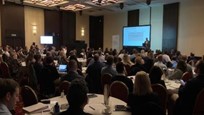
This year’s conference was held at the Millennium Gloucester Hotel in Kensington, London, in the Orchard room. Our theme was Futureproofing: Successful portfolio leadership and management in uncertain times, and the conference room was full with 148 participants, a record number for the SIG and just exceeding our previous peak in 2019.
Introduction Petula Allison, SIG Co Chair, opened the conference, welcoming delegates and speakers alike. As an ice-breaker Petula asked attendees to identify their greatest challenges over the past three years as well as the challenges anticipated in the coming three. Resources remained a constant challenge, but the future looks quite different to the past, with Covid, cost and gaining leadership buy-in replaced by AI, supplier availability, political instability, and the effects of Brexit and war. Portfolio management provides the framework for dealing with all of these, and we were invited to enjoy
Petula Allison, SIG Co Chair, opened the conference, welcoming delegates and speakers alike. As an ice-breaker Petula asked attendees to identify their greatest challenges over the past three years as well as the challenges anticipated in the coming three. Resources remained a constant challenge, but the future looks quite different to the past, with Covid, cost and gaining leadership buy-in replaced by AI, supplier availability, political instability, and the effects of Brexit and war. Portfolio management provides the framework for dealing with all of these, and we were invited to enjoy 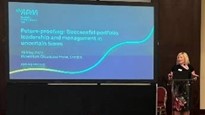 the day and take comfort from a packed room showing that we weren’t alone in facing these challenges.
the day and take comfort from a packed room showing that we weren’t alone in facing these challenges.
The Future of the Project Profession
APM Chief Executive Adam Boddison took to the stage as the first guest speaker and said how pleased he was to be attending the Portfolio Management conference - one of the APM’s flagship events. Adam linked the APM’s golden thread to portfolio management, covering three key themes:- talent; pragmatism and ethics. Adam remarked that the profession is often misunderstood, with many entry points to it and a number of sideways moves available. However, likening it to the Eagles’ Hotel California, “you can check out, but you can never leave!”.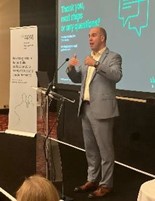 Looking to the future AI provides a mix of the scary and the exciting, but Adam was optimistic that it’s still mostly about people adding value, albeit as a profession we will need to become more data literate.
Looking to the future AI provides a mix of the scary and the exciting, but Adam was optimistic that it’s still mostly about people adding value, albeit as a profession we will need to become more data literate.
Some great insights came from Adam’s stories relating to observations made by his young children, demonstrating the value of unconstrained thinking and innovative ways to look at long established problems and ways of doing things. Coming back to the project profession, the many entry points to it and the current hot topic of accreditation, Adam left us with a question to ponder, “do we want our profession to be a regulated profession?”. There are upsides and downsides to that, so perhaps semi-regulated is the best place to settle upon.
Nationwide’s Portfolio Operating Model – organising for the flow of value
Tula introduced Tony Caink, the Head of Lean Portfolio Management at Nationwide. Tony highlighted the difference between building societies and banks, which is mainly a cultural
difference, as many of their processes and controls are the same with a heavy dependence on IT.

The Nationwide path has been a gradual evolution from projects to products, in line with industry trends. They have also moved from a centralised control to a federated model with clear, delegated accountability.
A critical area was working out how best to organise the people. The CIO now owns the complete change portfolio with the business line / function sub-portfolios owning the long term value streams and the fixed term programmes. The cross functional teams are tasked to meet their objectives and deliver the key results, which in turn achieve the outcomes owned by the value streams as part of their defined strategic programmes. The teams therefore are directly traceable to the strategic programmes and the Nationwide’s strategic drivers preserving the ‘golden thread’.
Nationwide also utilise a standard change model with dedicated accountability to deliver, and overall it has taken Nationwide 2-3 years to develop and fully implement the new ways of working.
Finally, Tony emphasised that Nationwide is a data-led organisation and identified three books he recommended to the participants which have contributed to the thinking; these are listed in the bibliography at the end.
Pirate Movement & Ninja Stealth: Futureproof portfolio maturity in a complex and volatile world Following the morning coffee break, Steve introduced Jo Stanford, the CEO of the Healthcare Project and Change Association (HPCA). Jo outlined the need for different skill sets to add value to the organisation and the Pirates and Ninja concept, referencing the books ‘Be More Pirate’ and ‘How to be More Pirate’ and then talked about creating effective team leadership using execution as learning. This led to John Kotter’s ‘Dual Operating Model’ of the management-driven hierarchy and the strategy acceleration network, and Jo discussed this model and how pirates can facilitate the network.
Following the morning coffee break, Steve introduced Jo Stanford, the CEO of the Healthcare Project and Change Association (HPCA). Jo outlined the need for different skill sets to add value to the organisation and the Pirates and Ninja concept, referencing the books ‘Be More Pirate’ and ‘How to be More Pirate’ and then talked about creating effective team leadership using execution as learning. This led to John Kotter’s ‘Dual Operating Model’ of the management-driven hierarchy and the strategy acceleration network, and Jo discussed this model and how pirates can facilitate the network.
Using Mentimeter Jo asked the delegates who in their organisation is involved in designing, delivering, approving, monitoring and assuring the portfolio and analysed and discussed the results on the screen.
In the next section Jo talked about the work of Tibisay Vera, creating a collaborative mindset with neuroscience, and outlined how the ‘online’ and ‘offline’ brain work. Using the sweets on each table, Jo asked us to take a sweet with childhood memories and think of happy moments and the sounds, scents etc. and to take note of the physical aspects while in this state, e.g. our breathing, illustrating a positive mindset. Talking through how this approach can help with change, and contrasting with more traditional approaches, Jo developed how best to apply neuroscience for managing change and creating a pirate movement and developing ninja skills to improve collaboration in portfolio maturity and benefits realisation. In the final section Jo asked the delegates on each table to identify the biggest challenge they were finding to developing portfolio maturity and realising the benefits, and to make a model from the Lego pieces on each table of how to overcome it using pirate and ninja moves. The solutions were showcased on the front table and a prize given for the best.
In the final section Jo asked the delegates on each table to identify the biggest challenge they were finding to developing portfolio maturity and realising the benefits, and to make a model from the Lego pieces on each table of how to overcome it using pirate and ninja moves. The solutions were showcased on the front table and a prize given for the best.
Jo summarised the presentation and her messages, referencing several useful books (see bibliography) and closed the session.
Tax in Taxing Times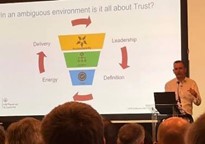 After lunch, Oliver Fisher, Chief Portfolio Officer at HMRC, briefly outlined his background, which was primarily delivery, and his role within HMRC which includes negotiating their budget with the government. HMRC is a non-ministerial department and is a custodian for millions of customer records. Payments include child benefits and the 2019 Covid financial support schemes. They are one of the largest employers in the UK with over 66,000 employees and revenues of around £730 bn p.a. His responsibilities include running the transformation portfolio of 40 programmes and about 100 projects with a three year budget of £6.3bn and HMRC is currently on a journey and is ‘digital by default’.
After lunch, Oliver Fisher, Chief Portfolio Officer at HMRC, briefly outlined his background, which was primarily delivery, and his role within HMRC which includes negotiating their budget with the government. HMRC is a non-ministerial department and is a custodian for millions of customer records. Payments include child benefits and the 2019 Covid financial support schemes. They are one of the largest employers in the UK with over 66,000 employees and revenues of around £730 bn p.a. His responsibilities include running the transformation portfolio of 40 programmes and about 100 projects with a three year budget of £6.3bn and HMRC is currently on a journey and is ‘digital by default’.
Oliver’s starting point is to ask ‘will the money continue to roll in?’.
The portfolio is organised into four groups:
- Delivering Government’s Tax Strategy (Digital Services)
- National Infrastructure (Remediate, Resilient & Secure)
- Infrastructure at the Border
- Ministerial Policy
Challenges include transforming the organisation while still maintaining a service, and keeping systems secure and performing, especially where there is a dependency on a few key skills. Oliver showed a cartoon of changing an aircraft’s engine in mid flight and in a thunderstorm to illustrate this point, with the caption “transformation can be bumpy, but you’re not flying alone”. He gave a few examples, including that you can’t turn off a server during peak performance and therefore need imaginative alternative ways of bringing new systems on line.
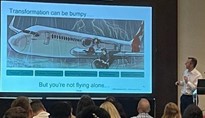
During the pandemic the Covid support schemes were complex and set up in a short space of time. Lessons learned showed that where the overarching priority was consistent from the
top to bottom within the organisation it was possible to move mountains. A clear vision meant that they could stand up systems quickly on new platforms. Harder to stand up were systems on current complex platforms and systems, and it takes time to unpick when there is a myriad of interfaces and dependencies, and if there are conflicting priorities. It is difficult to plan well when going into a systems environment not knowing what will be discovered. Supplier contracts were also being changed at the same time, adding additional complexity.
Portfolio management – both disaggregation and centralisation models have been tried and currently there is a mixed model.
Oliver closed with a slide on their approach, with clear accountability, context of the problem and trust – both customers and colleagues – as the backbone and leadership, clear definition of the problem, energy and delivery as the mechanism to achieve the portfolio goals.
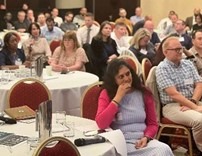
Question from the audience: How did Oliver set up the portfolio? Oliver explained that an external provider managed the portfolio for 18 months until December 2022. They rejigged the governance, looked at data, redeployed people and brought in standards. This has given them a good basis for moving forward.
Question from the audience: What is at the start of the portfolio cycle? Business cases are being used to outline the change and why it is needed, and the quality and strength of the case for change is key to assessing whether the investment will go ahead or not.
Leadership Traits Stephen White Stephen White, COO at Santander, joined us to share his reflections gained from a long career in the Finance sector, starting out as a cashier thirty years previously. His unique take on things included recommending employing 3-2-1 people not 1-2-3 people, those that make the right decisions for the organisation, then the team and finally the individual themselves, whilst also reminding us that we have one mouth and two ears for a good reason.
Stephen White, COO at Santander, joined us to share his reflections gained from a long career in the Finance sector, starting out as a cashier thirty years previously. His unique take on things included recommending employing 3-2-1 people not 1-2-3 people, those that make the right decisions for the organisation, then the team and finally the individual themselves, whilst also reminding us that we have one mouth and two ears for a good reason.

Stephen made the case for personal adaptability, observing that change has never been this fast, but will never be this slow again. The leader has to be the glue to bridge a constantly changing and uncertain world with people looking for certainty and predictability. Much emphasis was placed on trust and empathy, and as project people we were warned to look out for the watermelon effect – green on the outside but red on the inside – with Stephen reminding us that asking for help is a strength, not a weakness. In his closing remarks we were urged to create followship, create a legacy for the future and the people who are the future leaders.
Panel session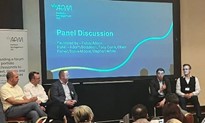
Panel members: Adam Boddison (APM), Oliver Fisher (HMRC), Stephen White (Santander), Steve Moore (Environment Agency), Tony Caink (Nationwide).
Petula Allison facilitated the questions and answers and started with a question on data and data-led organisations.
- Steve Moore outlined that data standards across industries differ widely. He cited the great work that the IPA are doing on data analytics and caveated that the adoption and optimal use of data analytics relies on data sharing, which historically has been a significant barrier.
- Oliver Fisher agreed, reinforcing that portfolio management relies on the ability to use a myriad of data. To this present day and despite their aspirations to be cutting edge, governments continue to make decisions on incomplete data and lack cutting edge portfolio management.
- Stephen White highlighted that there is not enough data in the supply side with a real need to understand capacity. Basic adoption is required before any transition to cutting edge can be made.
- Tony Caink spoke about his work at Nationwide and how their systems interconnect. For example, linking dependency management and business cases.
How do we build trust and leadership in the environment?
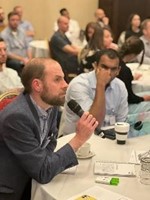 Adam Boddison spoke openly about the APM and how diversity still has a long way to go within the organisation. He outlined that he has built trust and leadership by changing their onboarding processes, ensuring regular contact and touch points with staff in person as well as a mixture of away days.
Adam Boddison spoke openly about the APM and how diversity still has a long way to go within the organisation. He outlined that he has built trust and leadership by changing their onboarding processes, ensuring regular contact and touch points with staff in person as well as a mixture of away days.- Oliver Fisher believes that the balance between working in the office and at home is critical. At HMRC he finds that leading a multifunctional team requires talking to people face to face and observing how people are behaving. He exemplified that you should operate as one team, coming together at both an intellectual and purpose level.
- Stephen White reaffirmed that leaders need to be able to adapt across multiple channels. Pre-covid travel was the biggest barrier and Santander have tried to remove frustrations surrounding travel by empowering employees.
- Tony Caink underlined the importance of getting your governance right and having transparency of the golden thread e.g. clear, defined accountabilities and goals.
What does the panel consider is the biggest risk in future-proofing portfolios?
- Stephen White outlined the criticality of alignment and goals, with a lack of prioritisation and choices often forming the root cause.
- Adam Boddison spoke about the biggest risk being complacency.
Steve Moore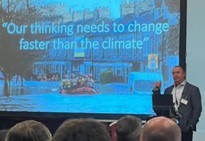 Steve Moore, Director of Operations for the Environment Agency (EA) held the final speaker’s slot of the day and approached 'future proofing' from a different angle to the rest of the presentations. He began by outlining the real question as he and his organisation sees it, that of responding to the climate and natural emergencies the world is currently experiencing. Some of the examples of flooding and severe droughts impacting various parts of the globe were hugely impactful.
Steve Moore, Director of Operations for the Environment Agency (EA) held the final speaker’s slot of the day and approached 'future proofing' from a different angle to the rest of the presentations. He began by outlining the real question as he and his organisation sees it, that of responding to the climate and natural emergencies the world is currently experiencing. Some of the examples of flooding and severe droughts impacting various parts of the globe were hugely impactful.
He went on to describe how the EA have recently altered their strategy aligning to three major points;
- Climate resilience
- Infrastructure design
- National response
Steve concluded that to maximise success of the £6bn EA portfolio, 'collaboration' is going to play a vital role - collaboration between organisations in managing common risks, efficient sourcing of materials, standards adhered to plus others. In doing this the EA is placing great focus on the culture and mindset of their colleagues to drive this vitally important agenda.
Closing
Steve invited anyone who wants to get involved to email the SIG, join the APM Community and our LinkedIn group. He then brought the day to a close by thanking the speakers, our sponsors – Imprend and nPlan - the APM Portfolio Management SIG committee, and the delegates in the room.
To find out more about the APM Portfolio Management Specific Interest Group:
i. Email us at portfoliosig@apm.org.uk
ii. Visit the SIG's microsite page and click on the ‘Follow this SIG button’ on the right hand side of the page.
iii. If you are an APM member you can also join the
Portfolio Management Interest Group on the APM Community which will enable you to keep up to date on the SIG’s latest news.
You can download the APM Community app (which is available for free) on the Apple Store and Google Play.
iv. There is also a APM Portfolio Management LinkedIn Group which you can join.
Bibliography
Books recommended by the speakers.
| Title | Author | Publisher | Year | Recommended by |
| Sooner, Safer, Happier | Jonathan Smart | IT Revolution Press | 2022 | Tony Caink ( chapter 5) |
| Project to Product | Mik Kersten | IT Revolution Press | 2019 | Tony Caink |
| The Delicate Art of Bureaucracy | Mark Schwartz | IT Revolution Press | 2020 | Tony Caink |
| Be More Pirate | Sam Coniff Allende | Penguin | 2018 | Jo Stanford |
| How to be More Pirate | Sam Coniff & Alex Barker | Own IT! | 2020 | Jo Stanford |
| Teaming | Amy Edmondson | Jossey-Bass | 2012 | Jo Stanford |
| Teaming to Innovate | Amy Edmondson | Jossey-Bass | 2013 | Jo Stanford |
| Neuroscience for Project Success | Carole Osterweil | APM | 2022 | Jo Stanford |
| Agile Change Management | Melanie Franklin | Kogan Page | 2021 | Jo Stanford |
| Neuroscience for Organisational Change | Hilary Scarlett | Kogan Page | 2019 | Jo Stanford |
| The Change Ninja Handbook | Tammy Watchorn | Practical Inspiration Publishing | 2022 | Jo Stanford |
| XLR8 | John Kotter | Harvard Business Review Press | 2014 | Jo Stanford |
| The Trustworthy Leader | Amy Lyman | Jossey-Bass | 2011 | Stephen White |
| Portfolio Management: A Practical Guide | APM Portfolio Management SIG | APM | 2019 | APM SIG committee |

0 comments
Log in to post a comment, or create an account if you don't have one already.